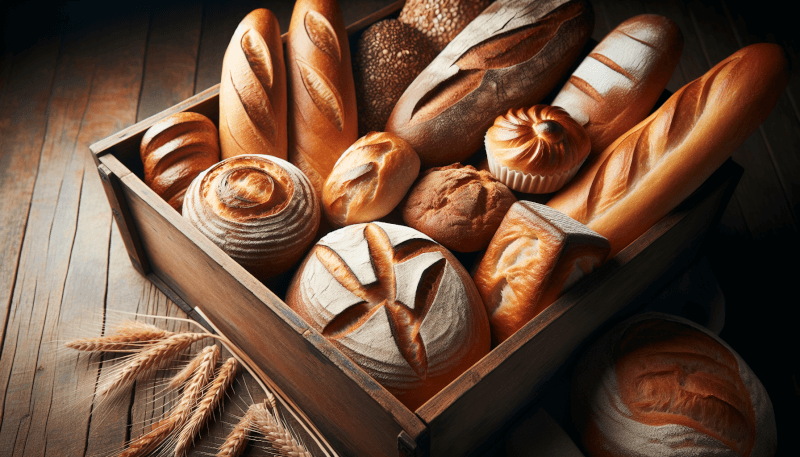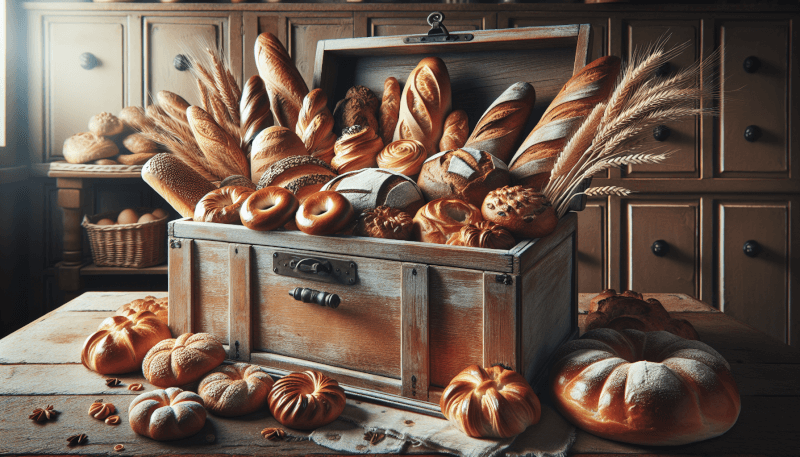If you’re a baking enthusiast or just love the comforting smell of freshly baked bread, then you know how important it is to store those homemade loaves and treats properly. With the right storage techniques, you can ensure that your bread stays fresh, flavorful, and delicious for days to come. In this article, we’ll guide you through some tried and true methods for storing homemade breads and baked goods with ease. From the best containers to use, to the ideal temperature and shelf life, you’ll learn everything you need to know to keep your baked creations in perfect shape. So, let’s get started and make sure those mouthwatering goodies stay as delightful as the day they were made!

Choosing the Right Storage Container
When it comes to storing your homemade breads and baked goods, choosing the right storage container is crucial. The container you use can make a big difference in maintaining the freshness and quality of your creations. Here are a few factors to consider when selecting a storage container:
Consider the Material
The material of the storage container plays a significant role in preserving the quality of your baked goods. Options like glass, plastic, and metal can all work well, but each has its advantages and disadvantages.
Glass containers are a popular choice because they are non-reactive and won’t absorb odors or flavors. They are also transparent, allowing you to easily see the contents inside. Plastic containers, on the other hand, are lightweight and often come with airtight seals, making them suitable for preserving freshness. Lastly, metal containers are durable and can offer additional protection against moisture and pests.
Ensure Airtight Seal
To keep your homemade breads and baked goods as fresh as possible, it’s important to choose containers with airtight seals. Airtight containers create a barrier against air and moisture, preventing your goods from drying out or becoming stale.
When selecting a container, look for ones with secure and tight-fitting lids. This will help maintain the optimal conditions for your baked goods and extend their shelf life.
Size Matters
Size is another crucial factor to consider when choosing a storage container. It’s essential to select a container that is appropriately sized for the amount and shape of your baked goods. If the container is too small, your goods may become squished or lose their shape. On the other hand, if the container is too large, there may be excess air inside, which can lead to accelerated staleness.
Consider the size of your baked goods and choose a container that allows for some extra space without being too big. This will ensure that your goods are stored properly and maintain their texture and taste.
Labeling
Labeling your storage containers is a simple yet effective way to keep track of your homemade breads and baked goods. By clearly labeling each container, you can easily identify the contents, as well as the date of storage. This will help you keep a rotation system, ensuring that you consume the oldest goods first.
Use waterproof labels or permanent markers to prevent smudging or fading. Additionally, include any specific instructions or notes, such as the type of bread or any special ingredients, to help you choose the right container when you’re ready to enjoy your baked goods.
Storing Homemade Breads
Homemade bread is a delightful treat, and proper storage is essential to maintain its freshness and flavor. Here’s how to store your homemade breads:
Cooling the Bread
Before storing your homemade bread, it’s important to cool it properly. Allow the bread to cool completely on a wire rack, as placing it directly into a storage container while it’s still warm can trap moisture and promote the growth of mold.
Wrap in Plastic or Foil
Once your bread has cooled, it’s essential to protect it from air and moisture. Wrap the bread tightly in plastic wrap or aluminum foil, ensuring that it is fully sealed. This will help preserve the freshness and prevent the bread from drying out.
Using Bread Bags
Bread bags are specifically designed to keep your bread fresh for longer periods. Place your wrapped bread inside a bread bag, ensuring that it is completely enclosed. Bread bags are designed to allow a minimal amount of air circulation, preventing moisture buildup while still maintaining optimal conditions for your bread.
Freezing Breads
If you have made an abundance of bread or want to store it for an extended period, freezing is an excellent option. To freeze your homemade bread, wrap it tightly in plastic wrap and then place it in a freezer bag or airtight container.
When you’re ready to enjoy the bread, allow it to thaw at room temperature. Avoid thawing it in the microwave as it can cause the bread to become soggy or lose its texture.
Reheating Frozen Breads
To revive frozen breads, preheat your oven to 350°F (175°C). Remove the bread from the freezer bag or container and unwrap it from the plastic wrap. Place the unwrapped bread directly on the oven rack or a baking sheet, and bake for approximately 10 minutes or until heated through. This will help restore the freshness and crispness of the bread.

Storing Freshly Baked Cookies
Freshly baked cookies are a delight, and ensuring their freshness is key to maintaining their taste and texture. Here’s how to store them properly:
Allow Cookies to Cool
After removing your cookies from the oven, allow them to cool on a wire rack. This will prevent them from becoming soggy and help them retain their crispness.
Using Cookie Tins
Cookie tins are a classic and effective way to store freshly baked cookies. The metal tins provide a dark and cool environment, which helps maintain the cookies’ texture and flavor. Be sure to choose a tin that is appropriately sized for the amount of cookies you are storing to prevent them from breaking or becoming crushed.
Using Airtight Containers
If you don’t have cookie tins, airtight containers can also work well for storing freshly baked cookies. Choose containers that provide a tight seal to prevent air and moisture from entering. Plastic containers with locking lids or glass containers with rubber seals can be excellent options.
Separating Delicate Cookies
If you have a variety of delicate and crisp cookies, it’s important to separate them to prevent them from sticking together or losing their texture. Place a layer of parchment paper, wax paper, or even plastic wrap between each layer of cookies to create a barrier.
Refrigeration or Freezing
Refrigeration is generally not recommended for storing freshly baked cookies, as it can cause them to become stale faster. However, certain types of cookies, such as those with cream fillings, may benefit from being refrigerated to maintain their freshness.
If you need to store cookies for an extended period, freezing is the best option. Wrap the cookies tightly in plastic wrap, place them in an airtight container, and store them in the freezer. When you’re ready to enjoy the cookies, allow them to thaw at room temperature.
Preserving Pastries and Pies
Preserving pastries and pies is important to ensure they maintain their delicate textures and flavors. Here are some tips for storing these baked goods:
Refrigerating or Freezing Pastries
When it comes to pastries, refrigeration is generally the best option for short-term storage. Place your pastries in an airtight container or wrap them tightly in plastic wrap and store them in the refrigerator. This will help maintain their freshness and prevent them from drying out.
For long-term storage, freezing is recommended. Wrap each pastry tightly in plastic wrap and place them in a freezer bag or airtight container. Frozen pastries can typically last for several months and make for a convenient treat when you’re in the mood for something sweet.
Storing Fruit Pies
Fruit pies require specific storage techniques to preserve their flavors and prevent them from becoming mushy. After baking, allow the pie to cool completely before storing.
To store fruit pies, place them in the refrigerator, uncovered, for a few hours. This will help the filling set and prevent excess moisture from accumulating in the crust. Once the pie has cooled, cover it with plastic wrap or place it in an airtight container to maintain its freshness.
Storing Cream or Custard Pies
Cream or custard pies require extra care to maintain their creamy textures. Store these pies in the refrigerator, covered loosely with plastic wrap or aluminum foil. Avoid placing any heavy items on top of the pies, as it can cause the fillings to become compressed and lose their smoothness.
Maintaining Crispy Pastry
To maintain the crispness of pastries, such as croissants or puff pastry, it’s best to store them in paper bags. The paper allows for air circulation while preventing excess moisture from accumulating. Place the pastries in a paper bag and loosely fold the opening to keep them fresh.
Reheating Pastries
When you’re ready to enjoy your pastries, reheating can help restore their crispness and enhance their flavors. Preheat your oven to a low temperature, around 325°F (160°C). Place the pastries on a baking sheet and warm them in the oven for a few minutes. The gentle heat will revive the pastry and make them taste freshly baked.

Storing Cakes
Proper storage is crucial for preserving the moistness and flavor of cakes. Whether you’re dealing with frosted cakes or cut cakes, here’s how to store them effectively:
Refrigeration or Room Temperature
The storage method for cakes depends on the type of cake you have. Generally, uncut cakes with buttercream or cream cheese frostings should be stored in the refrigerator. The cold temperature will help maintain the integrity of the frosting and prevent it from melting or becoming too soft.
Uncut cakes with other frostings, such as whipped cream or ganache, can be stored at room temperature for a day or two. However, it’s important to keep them in a cool and dry environment away from direct sunlight or heat sources.
Properly Wrapping Cakes
To protect your cakes from drying out, it’s crucial to wrap them properly. Whether you’re storing them in the refrigerator or at room temperature, cover the cake tightly with plastic wrap or aluminum foil. This will create a barrier against air and moisture, ensuring that the cake retains its moisture.
Freezing Cakes
If you want to store a cake for an extended period or have leftover cake that needs preserving, freezing is a great option. First, ensure that the cake has cooled completely. Then, tightly wrap the cake in plastic wrap and place it in a freezer bag or an airtight container. Freezing can help preserve the texture and flavors of the cake for several months.
Storing Frosted Cakes
When it comes to storing frosted cakes, it’s important to take extra precautions to maintain the appearance and texture of the frosting. Place the cake in the refrigerator, uncovered, for about 30 minutes to allow the frosting to set. Once the frosting has hardened slightly, cover the cake with a cake dome or place it in an airtight container to prevent the frosting from smudging or sticking to the cover.
Storing Cut Cakes
If you have a partially eaten or cut cake, storing it properly is essential to prevent it from drying out. Apply plastic wrap directly to the cut sides of the cake, ensuring that it adheres to the surface. This will help maintain the moisture and prevent the cake from becoming stale. Additionally, cover the remaining whole cake with plastic wrap or place it in an airtight container to maintain its freshness.
Keeping Muffins and Cupcakes Fresh
Muffins and cupcakes are popular treats, and proper storage is crucial to preserve their moisture and flavors. Here’s how to keep them fresh:
Cooling Muffins and Cupcakes
After baking muffins or cupcakes, allow them to cool completely on a wire rack. This will prevent excess moisture from accumulating and help them retain their texture. Avoid storing them while they are still warm, as it can create condensation and cause them to become soggy.
Storing in Airtight Containers
Airtight containers are excellent for storing muffins and cupcakes. Choose containers that provide a tight seal to prevent air from entering and moisture from escaping. Plastic containers with locking lids or glass containers with rubber seals are both suitable options.
Place your muffins or cupcakes in the container, ensuring that they are not overcrowded. Overcrowding can lead to the treats becoming squished or losing their shape. If you have multiple layers of muffins or cupcakes, separate them with parchment paper or cupcake liners to prevent sticking.
Using Cupcake Holders
If you’re looking for a convenient way to store individual cupcakes, cupcake holders can be a great choice. These plastic or silicone holders fit snugly around each cupcake, protecting them from air and physical damage. Cupcake holders are especially useful when transporting your baked goods or storing them in the freezer.
Refrigeration or Freezing
While it’s generally best to consume muffins and cupcakes within a few days of baking, refrigeration can help extend their shelf life. If you’re storing them for a short period, place them in an airtight container and store them in the refrigerator. Avoid refrigerating them for too long, as it can cause them to dry out faster.
For longer-term storage, freezing is the preferred method. Simply wrap each muffin or cupcake tightly in plastic wrap and place them in a freezer bag or airtight container. Frozen muffins and cupcakes can last for several months and can be thawed when you’re ready to enjoy them.
Refreshing Stale Muffins
If you find yourself with stale or slightly dried-out muffins, there’s a simple trick to revive them. Place the muffins on a microwave-safe plate and cover them with a damp paper towel. Microwave them on low power for a short amount of time, checking them periodically, until they become soft and moist again. This method can help bring back some of the freshness to your muffins.

Maintaining the Freshness of Rolls and Buns
Rolls and buns are versatile and delicious baked goods, and proper storage is essential to maintain their softness and flavor. Here’s how to keep them fresh:
Reheating Rolls and Buns
For rolls and buns that have become slightly stale, reheating is an excellent way to bring back their freshness. Preheat your oven to 350°F (175°C) and place the rolls or buns on a baking sheet. Bake them for a few minutes until they are heated through. The gentle heat will help restore their softness and make them taste freshly baked.
Storing in Paper Bags
When it comes to storing rolls and buns, paper bags can be a great option. The paper allows for air circulation while preventing the bread from drying out too quickly. Place your rolls or buns in a paper bag, loosely fold the opening to keep them fresh, and store them in a cool and dry place.
Using Bread Boxes
Bread boxes are another excellent solution for storing rolls and buns. These specially designed containers provide a dark and cool environment, which helps maintain the softness and flavor of the bread. Bread boxes usually have ventilation holes or a wooden lid that allows for proper air circulation, preventing excess moisture buildup.
Freezing Rolls and Buns
To store rolls and buns for an extended period or prevent them from going stale, freezing is the best option. Wrap each roll or bun tightly in plastic wrap and place them in a freezer bag or an airtight container. Frozen rolls and buns can last for several months and can be easily thawed when needed.
Reviving Stale Rolls
If you find yourself with stale rolls, there are a few methods you can use to bring back their freshness. One option is to sprinkle the rolls lightly with water and place them in a preheated 350°F (175°C) oven for a few minutes. The steam created by the water will help rehydrate the bread and make it softer.
Another method is to lightly dampen a clean kitchen towel and wrap the stale rolls in it. Place the wrapped rolls in a preheated 350°F (175°C) oven for a few minutes until they become warm and moist. The steam from the damp towel will help revive the rolls and make them taste freshly baked.
Storing Homemade Bread Crumbs
Homemade bread crumbs are a versatile ingredient that can add a delightful crunch to various dishes. Here’s how to store them properly:
Making and Drying Bread Crumbs
To make homemade bread crumbs, start by drying out your bread. Cut the bread into small pieces and spread them out on a baking sheet. Place the baking sheet in a preheated oven at a low temperature, around 250°F (120°C), and let the bread dry out for about 30 minutes or until it becomes completely crispy. Allow the dried bread to cool before moving on to the next step.
Next, transfer the dried bread to a food processor or blender and pulse until you achieve the desired crumb consistency. Be sure not to overprocess the bread, as it may turn into a fine powder rather than crumbs.
Storing Bread Crumbs
Once you have your homemade bread crumbs, it’s important to store them properly to maintain their texture and freshness. Transfer the bread crumbs to an airtight container, such as a glass jar or a plastic container with a tight-fitting lid. Be sure to choose a container that is appropriately sized for the amount of bread crumbs you have.
Freezing Bread Crumbs
If you have a surplus of homemade bread crumbs or want to store them for an extended period, freezing is the best option. Place the bread crumbs in a freezer bag or an airtight container and store them in the freezer. Frozen bread crumbs can last for several months without losing their texture or flavor.
When you need to use the frozen bread crumbs, simply remove the desired amount from the freezer and allow them to thaw at room temperature before incorporating them into your recipes.
Using Airtight Containers
To prevent moisture from seeping into your bread crumbs, it’s crucial to store them in airtight containers. Airtight containers create a barrier against air and humidity, ensuring that the bread crumbs retain their crispness and flavor. Additionally, storing them in airtight containers helps keep pests away, ensuring that your bread crumbs remain safe to use.

Handling Gluten-Free Baked Goods
If you’re dealing with gluten-free baked goods, proper storage is essential to maintain their texture and prevent cross-contamination. Here are some tips for handling gluten-free baked goods:
Choosing Appropriate Storage Options
When storing gluten-free baked goods, it’s important to choose storage options that are free from gluten contaminants. Dedicated containers, separate from those used for gluten-containing products, should be used to prevent cross-contamination. Ensure that these containers are clean and free from any residual gluten particles.
Preventing Drying Out
Gluten-free baked goods can be more susceptible to drying out compared to their gluten-containing counterparts. To prevent drying, wrap your gluten-free breads, cakes, or cookies tightly in plastic wrap or store them in airtight containers. This will create a barrier against air and moisture, helping the baked goods retain their moisture and freshness.
Freezing Gluten-Free Baked Goods
If you have a surplus of gluten-free baked goods or want to store them for an extended period, freezing is an excellent option. Follow the same process as storing regular baked goods: tightly wrap the individual items in plastic wrap and place them in a freezer bag or an airtight container.
Freezing gluten-free baked goods can help preserve their freshness and prevent them from drying out. Be sure to label the containers with the date of storage to keep track of their expiration dates.
Labeling for Allergens
An important consideration when storing gluten-free baked goods is labeling for allergens. Make sure to clearly label all containers with the necessary information, such as “gluten-free” and any other relevant allergen warnings. This will help you and others in your household identify the specific dietary restrictions and prevent accidental consumption of gluten.
Long-Term Storage for Baked Goods
If you’re looking to store your baked goods for an extended period, proper long-term storage techniques are essential. Here are some tips to help you maintain the quality of your baked goods over time:
Vacuum Sealing Technique
One effective method for long-term storage is using a vacuum sealer. Vacuum sealing creates an airtight environment around your baked goods, preventing air and moisture from entering. This helps preserve the texture, freshness, and flavor of the goods for an extended period.
Simply place your baked goods in a vacuum-seal bag or container, follow the manufacturer’s instructions for sealing, and remove the excess air from the bag. Vacuum-sealed goods can last significantly longer without sacrificing quality.
Freezing for Extended Periods
Freezing is one of the best methods for long-term storage of baked goods. It helps maintain the freshness and texture while preserving flavors. However, it’s important to use proper freezing techniques to ensure optimal quality.
Before freezing your baked goods, make sure they have cooled completely. Wrap them tightly in plastic wrap or aluminum foil, or place them in airtight containers. Removing excess air will help prevent freezer burn and maintain the taste and texture.
Maintaining Quality over Time
To maintain the quality of your baked goods over time, it’s important to handle them with care. Avoid exposing them to temperature fluctuations or direct sunlight, as these can accelerate the deterioration process.
When retrieving baked goods from long-term storage, allow them to thaw at room temperature before consuming. This will help them regain their original texture and taste.
Proper Thawing Methods
When it’s time to enjoy your long-term stored baked goods, be sure to thaw them properly. Avoid using the microwave for thawing, as it can cause the goods to become soggy or lose their texture.
To thaw your baked goods, remove them from the freezer and place them in the refrigerator overnight. This slow thawing process will help maintain the moisture and prevent any drastic changes in texture. Once fully thawed, you can enjoy your baked goods as if they were freshly made.
In conclusion, storing homemade breads and baked goods requires careful consideration of the right storage containers and techniques. By following the tips outlined in this comprehensive guide, you can ensure that your baked creations stay fresh, delicious, and enjoyable for an extended period of time. Remember, proper cooling, wrapping, and storing are the keys to maintaining the quality of your homemade treats. So, go ahead and enjoy your delectable creations with the confidence that they’ll be just as tasty days after baking!


